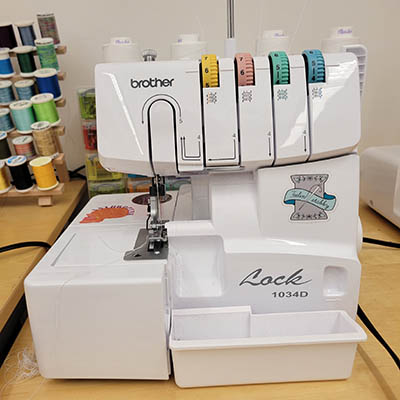
Sewing a seam that needs to stretch? That's a job for me, the Brother 1034d serger. Bring me all your stretchy fabrics and I'll make you some seams that can move without breaking or puckering or pulling.
But that's not all I can do! If you're working with a fabric that wants to unravel -- like, as soon as you cut it, the edge starts falling apart in your hands -- you can use me along the edge to stop it from unraveling.
Even if your fabric isn't so fragile, I can be a quick and easy way to finish seams on woven items. Look around at seams on tote bags and such, you'll often see my signature 4-thread stitch.
Supplies
I go through a lot of thread, so you want to use the cones. You might think one thread cone is like another, but honestly, a high-quality thread matters to me, especially with regard to tension. It's Maxilock or bust! I'm often threaded in gray which works well enough for most things, but if you're doing an all-black garment in particular, it can be worth rethreading me in black.
Tricks and tips
Serger threading is no joke when you're getting started. To check if I'm threaded correctly, just hit the pedal: are all four threads chaining together neatly? If not, something might be wrong: try serging some scrap fabric and see how it looks. If you need to rethread me, check out the video below -- and it's perfectly fine to ask for help, it takes some practice to get comfortable threading a serger.
One thing about the tension: to make it so the stitches don't show in the seam, you need to get the tension right. But there's no absolute set of numbers that will always do it -- it's less about the numbers themselves, and more about where they are relative to one another. Start somewhere in the middle (4 or 5) and increase the tension on the left and right needles until you're not seeing the stitches. Sometimes you can get there with the highest number at 4-5.
Fun facts
I was one of the first machines Quinn bought to create the Textile Makerspace. Quinn has the same model at home (and, tbh, has gone through a couple of these machines over the years.)
Instructions
- Manual
- Threading the Brother 1034d serger (video)
- Serger tension (video)